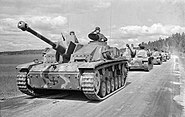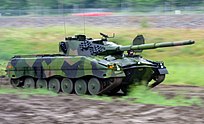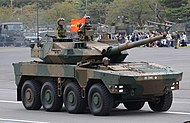Assault_gun
Assault gun
Class of self-propelled artillery
An assault gun (from German: Sturmgeschütz, lit. 'storm gun', meaning "assault gun")[1] is a type of self-propelled artillery[2] which uses an infantry support gun mounted on a motorized chassis, normally an armored fighting vehicle,[3] which are designed to provide direct fire support for infantry attacks, especially against other infantry or fortified positions.[1] Assault guns were pioneered by the Soviet Union and Nazi Germany during the 1930s, initially being self-propelled guns with direct fire in mind (such as the Soviet SU-5-1), with Germany introducing the first purpose-built (and purpose-named) assault gun, the Sturmgeschütz III, in 1940.[1]
This article needs additional citations for verification. (January 2013) |
Top right: US WWII M4A3 (105) assault gun.
Lower left: Swedish Cold War Ikv 91 assault gun.
Lower right: Japanese Type 16 Maneuver Combat Vehicle (Japanese: 16式機動戦闘車) modern assault gun.
Historically, the concept of assault guns was very similar to that of the infantry tank, as both were combat vehicles intended to accompany infantry formations into battle.[4] However, during World War II assault guns were more mobile than tanks and could be utilized as both direct and indirect fire artillery.[4] Although they could approximate the firepower of a tank, assault guns mostly fired high explosive shells at relatively low velocities, which were well suited for their role of knocking out hard points such as fortified positions and buildings.[4] They were not intended to be deployed as tank substitutes or dedicated tank destroyers.[4] Nevertheless, as the conflict progressed, the increasing proliferation of tanks on the battlefield forced many assault gun units to engage armor in defense of the infantry, and led to armies becoming more dependent on multipurpose designs which combined the traditionally separate roles of an assault gun and a tank destroyer.[5]
German and Soviet assault guns introduced during World War II usually carried their main armament in a fully enclosed casemate rather than a gun turret.[6] Although this limited the field of fire and traverse of the armament, it also had the advantage of a reduced silhouette and simplified the manufacturing process.[6] The United States never developed a purpose-built assault gun during the war, although it did modify preexisting armored fighting vehicles for that role, including the M4 Sherman (as the M4(105)), the M5 Stuart (as the M8 Scott), and the M3 half-track (as the T19 Howitzer Motor Carriage).[7] The classic assault gun concept was largely abandoned during the postwar era in favor of tanks or multipurpose tank destroyers attached to infantry formations, which were also capable of providing direct fire support as needed. In the United States and most Western countries, the assault gun ceased to be recognized as a unique niche, with individual examples being classified either as a self-propelled howitzer or a tank,[8] one exception being Sweden, which continued to develop casemate assault guns post-war, such as the Infanterikanonvagn 72, all the way into the 1960s before settling on a turreted design in 1968, becoming the Infanterikanonvagn 91.[9] The Soviet Union continued funding development of new assault guns as late as 1967, although few of its postwar designs were adopted in large numbers.[10] In Soviet and Eastern European armies, the traditional assault gun was primarily superseded by tank destroyers, such as the SU-100, which is capable of supporting either infantry or armor.[8] Since the 1980s, the multi-purpose assault gun concept has seen a resurgence, mainly in the form of turreted wheeled designs, such as the South African Rooikat and Italian Centauro. Today, modern assault guns include the Japanese Type 16 Maneuver Combat Vehicle and the American M1128 Stryker and M10 Booker.



